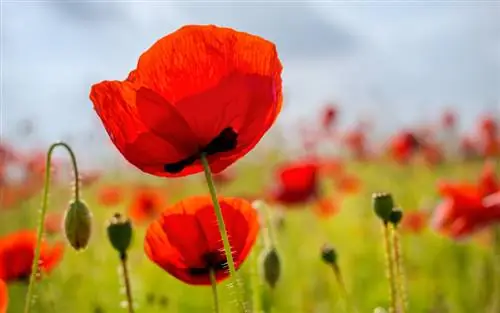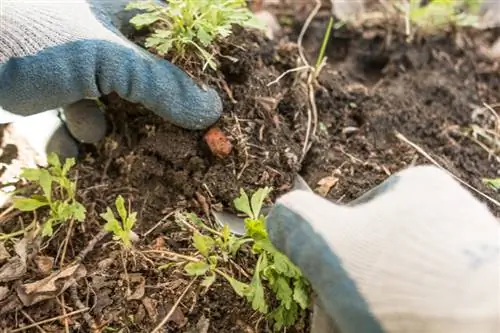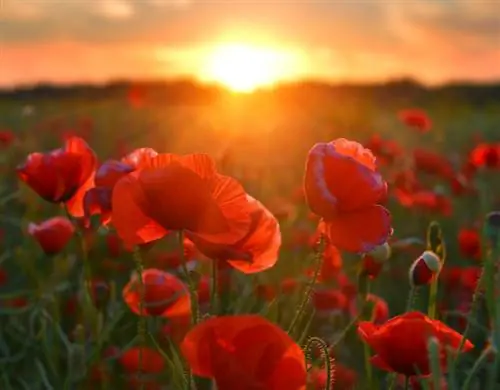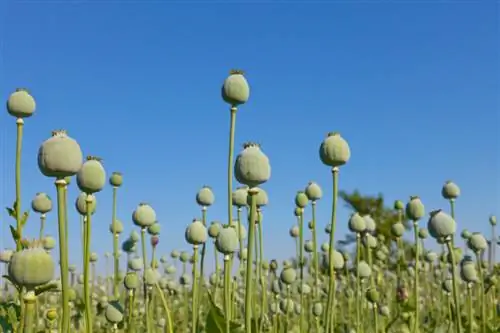- Author admin [email protected].
- Public 2023-12-25 17:45.
- Last modified 2025-01-23 11:22.
In the wild, the red flowers of the corn poppy rarely dance across meadows and fields. Reason enough to offer the annual summer flower a home in the natural garden. The following answers to frequently asked questions show how uncomplicated this delicate beauty is.

How do you optimally care for corn poppies?
For optimal growth, corn poppies require a sunny, wind-protected location with loose, permeable and nutrient-rich soil. Minimal care includes watering in dry conditions, occasional fertilizing and cutting off wilted flower stems.
Planting corn poppies correctly
Ready-grown poppies can be planted from mid-April, provided the weather permits. As long as the ice saints still threaten to be present at night, the flower should not be placed outdoors. While you weed and rake the bed soil, the root ball is allowed to soak up water. Dig small holes 45-55 cm apart and mix the excavated material with compost and horn shavings. Then pot up the young poppies and plant them in the soil up to the bottom pair of leaves. After watering, a mulch layer of leaves, bark mulch or grass clippings contributes to vital growth.read more
Care tips
The minimal care program for a poppy can be easily managed even by hobby gardeners with limited time. We are talking about these manageable measures:
- Water corn poppies directly to the roots when it is dry
- In lean soil or in pots, fertilize every 4 weeks from April until the end of the flowering period
- Cut off flower stems as soon as they wilt
Since corn poppies take care of their own reproduction with bulging seed capsules, the last flowers of the season remain in the bed. After the petals fall off, the capsule fruits ripen and burst open, spreading the fine seeds throughout the garden.
Which location is suitable?
If the poppy is pampered by the sun's rays for several hours every day, it will give its best in its location. In partial shade, the flower bloom usually falls short of expectations. A location protected from the wind prevents ruffled flower heads, so a location in front of the south wall of the house is wisely chosen. So that the long taproot can penetrate the soil unhindered to a depth of 1 meter, the soil should be loose, permeable and rich in nutrients.
The correct planting distance
With an average height of 30 to 80 cm with a clump-like habit, we recommend a planting distance of 45 to 55 cm. If you arrange corn poppies in small tuffs with 5-10 specimens each, the enchanting cup flowers will come into their own impressively.
What soil does the plant need?
Poppies thrive in any good garden soil. The poppy plant shows its most beautiful side when it is presented with sandy-loamy to gravelly-loamy and calcareous soil conditions. Since waterlogging is a poppy's worst enemy, close proximity to a body of water should be avoided. If you cultivate the poppy in a balcony box or bucket, it will thrive wonderfully in standard compost-based potting soil, enriched with a handful of vital lime.
What is the best time to plant?
From April, specialist retailers will be offering pre-grown young plants in containers that you can immediately plant in the bed or pot. If you want to plant corn poppies in the garden by sowing, the planting time is from mid-March to the end of May. Autumn sowing in September/October results in extra early flowering, but is regularly threatened by the rigors of winter weather. If you decide to sow in autumn, you cannot avoid winter protection for the seedbed in the form of straw, brushwood or garden fleece.
When is flowering time?
Common poppy displays its bright red or white flowers from May to July. A single terminal flower lasts 2 to 3 days before withering. Since new inflorescences continue to develop throughout the entire flowering period, the colorful magic continues seamlessly. Cut off spent flower stems and encourage additional corn poppies. If you wish to sow this magnificent summer flower yourself, it should be given the opportunity to form the seed heads. In this case, the withered flowers must not be cut off at the end of summer.read more
Cut poppies correctly
The corn poppy, as an annual summer flower, does not require pruning for shape and maintenance purposes. However, if you take the time to cut off withered flower stems, your effort will be rewarded with a long flowering period. If you feel bothered by the dead leaves in autumn, cut them off close to the ground. Please consider the toxic content of the latex and, to be on the safe side, wear gloves so as not to cause skin irritation.
Watering corn poppies
The corn poppy knows how to cope with short-term drought, whereas waterlogging means the premature end of the atmospheric floral display. Water the natural beauty when the summer is dry, avoiding targeted bombardment with the garden hose. Ideally, you should give the water from the spout of the watering can directly to the roots. In contrast, pots and flower boxes are watered regularly, as the flower here cannot extend its taproot to the groundwater, as in the garden soil.read more
Fertilize corn poppies properly
In the nutrient-rich location, there is no need to add fertilizer, as the table is richly set for corn poppies. If in doubt, starting fertilization in April with compost and horn shavings will give the poppy the desired growth boost. If the soil proves to be too acidic, remedy the situation by repeatedly applying lime or rock powder. In the pot or balcony box, administer a liquid fertilizer for flowering plants (€9.00 on Amazon) in diluted concentration every 4 weeks until the end of the flowering period.
Propagate corn poppies
The propagation of corn poppies can be achieved without much fuss by sowing directly into the bed. Prepare a fine, crumbly seedbed in a sunny, nutrient-rich location. As soon as the temperatures exceed 15 degrees from mid-March, sow the fine seeds widely. If you mix this with a little bird sand beforehand, the seeds will spread better. Sieve the seeds thinly with fine soil, sand or vermiculite. After the substrate has been sprayed with water, spread a close-meshed net over it as a precaution. You can look forward to the first seedlings within 8 to 14 days.read more
Poppies in a pot
In the pot, corn poppies attract everyone's attention with their picturesque flowers. To ensure that it spreads this magic over many weeks of summer, care is all about the following measures:
- If the substrate dries, water it directly to the roots
- From April until the end of the flowering period, fertilize liquidly every 4 weeks in a diluted concentration
- Immediately cut off withered flower stems to encourage repeat blooms
Leave the last poppy flowers in the pot until the seed pods have developed. Inside there are valuable seeds for the next generation of flowers.
Is corn poppy poisonous?
Common poppy is poisonous in all parts. The white milky juice in particular contains a high dose of toxic alkaloids. If a large amount of the seeds are consumed, considerable stomach and intestinal problems occur. First and foremost, children fall victim to the bright red seduction and stuff the flowers and seeds into their mouths. The result is stomach pain, vomiting and diarrhea. The same thing happens to domestic animals, grazing cattle and horses. Therefore, only cultivate corn poppies in locations where children and animals cannot access the flower.read more
How do I harvest and sow corn poppy seeds?
When a corn poppy has finished its flower festival this year, the withered petals fall off and the seed capsule develops. Once it has reached maturity, you will see several small holes in the lid of the capsule. Carefully cut off the capsule and place it in a fine tea strainer so that the tiny seeds are not lost. Take the seeds out of the capsule in a dry, wind-protected place. Now it is up to you to decide whether you should sow the seeds in the bed immediately or wait until the following March. The sowing process always takes place in these steps:
- Weed the soil in a sunny, wind-protected location, cleaning it from stones and roots
- First with the rake, later with the rake, prepare the soil until it is finely crumbly
- Sow the seeds widely in order to sift them thinly with sand, soil or vermiculite
After moistening the bed with a fine spray, spread out a close-meshed net, otherwise the seeds will end up in the beaks of pecking birds or in the hungry stomachs of animal garden inhabitants. At a constant temperature of 15-20 degrees Celsius, germination begins within 8-14 days. During this time, keep the bed free of weeds and constantly slightly moist.read more
What effect do poppy flowers have?
Although conventional medicine vehemently denies it, herbalists have sworn by the calming effects of poppy flowers for generations. Dried and prepared as a tea, poppy flowers soothe tense nerves without any harmful side effects. However, the plant does not contain any morphine, as is the case with opium poppies. Collect the flowers as soon as they have opened. Dry the harvest in an airy, not too bright place. With a bit of luck the red color will remain. However, the petals sometimes take on a grayish color, which does not affect their effectiveness. Pour boiling hot water over it, let the tea steep for 15 minutes and enjoy it in small sips. Anyone who suffers from skin problems washes themselves repeatedly with the tea to get relief.read more
Beautiful varieties
- Angels Choir: Magnificent variety with bright red, lush double flowers
- Cabrita: Historical variety from 1800 with pure white cup flowers, ideal for the romantic cottage garden
- Pierrot: Red cupped flowers with noticeable black spots characterize this variety
- Ladybird: Graceful dwarf variety with red, black cupped flowers; ideal for balcony boxes and pots
- Silk Poppy: Large-flowered mix of red, white and pink flowers with double flowers






